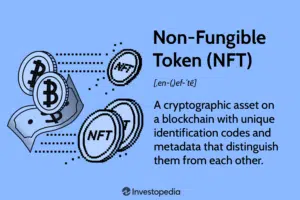What Are Non-Fungible Tokens?
Non-fungible tokens (NFTs) differ from traditional cryptocurrencies like Bitcoin because they are unique and not interchangeable on a one-to-one basis.
Fungibility refers to the property of an asset or currency where each unit is identical and can be exchanged with another unit without any differences in value.

Non-Fungible Token (NFT) | Source: Investopedia
In contrast, non-fungible tokens represent something distinct and cannot be directly exchanged with other tokens of the same type.
One common application of NFTs is in the representation of digital art.
The Diverse Applications of Non-Fungible Tokens (NFTs)
Additionally, NFTs can be used to tokenize real-world assets such as equity or commodities.
By representing these assets as non-fungible tokens, they can be traded digitally while maintaining their unique characteristics.
In some cases, a token may become non-fungible due to its past history or known activities.
For example, if a certain amount of Bitcoin, typically fungible, has been used for illicit purposes or associated with illegal activities, it may become less or non-fungible.
In such cases, it may be difficult for these tokens to be accepted by exchanges and other service providers.
Non-fungible tokens have gained significant attention and popularity, especially within digital art and collectibles, where the uniqueness and scarcity they represent can hold considerable value and appeal to collectors.